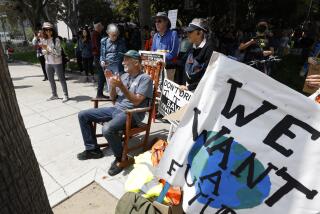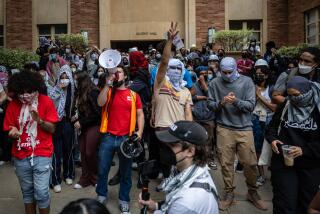At one time, being a patriot to Dell Herndon was going to war. Now it’s marching for peace.
- Share via
Dell Herndon turned and stared right into his past.
He spotted a Japanese woman, who he learned later was from a city he had once bombed as a B-29 gunner in World War II. She was young, about college-age, and she had come from her homeland to volunteer to walk across America to promote peace and nuclear disarmament. Herndon, a retired machinist, had also just signed up to make the coast-to-coast trek.
“I was old enough to be her father,” Herndon, 67, recalled recently. “All I could think about was what we did to her country. Now I realize it was brutal and senseless. I approached her, and then. . . .”
Herndon didn’t finish the thought. He didn’t have to. His eyes, welling up with tears, clearly told of how emotional the moment had been for the longtime Whittier resident.
That chance encounter more than a year ago in the small Santa Monica headquarters of PROPeace underscores why Herndon is now walking from Los Angeles to Washington.
At one time, being a patriot to Herndon was going to war.
Today, it’s passing through towns like St. George, Utah, and Council Bluffs, Iowa, spreading the word about the threat posed by the nuclear worldwide arms buildup.
Herndon has been with the coast-to-coast peace march since the movement’s rocky start in March. Organizers had predicted 5,000 people would make the nine-month walk, ending with a massive rally in November at the White House gates. But a shortage of money and supplies, and internal bickering among organizers has hurt the movement, now known as the Great Peace March. About 500 people have stuck with the march, which is nearing Missouri.
But Herndon, who was in Whittier recently for a few days of rest before rejoining the march, said the group’s troubles are over. “Those who are left are committed,” he said. “We are going all the way.”
And what will Herndon tell the President if he should meet with the group when they reach the nation’s capital this fall?
“The message is simple,” he said. “Cooperate with the rest of the world in destroying these missiles.”
Herndon’s conversion to peace politics did not occur overnight.
When he returned from the Pacific after the war, Herndon said, he was the “most rabble-rousing Republican you’ve ever seen,” conservative and convinced that military might was the only effective deterrent. But he said the growing number of armed conflicts around the globe softened his hawkish stance, and in the mid 1970s he switched political parties and viewpoints on military spending.
Herndon was also increasingly troubled about his role in World War II.
He had enlisted in the Army Air Corps for all the right reasons. But it wasn’t until his first bombing run over Japan that the gravity of what he was doing took focus.
“On that first mission they told us we were going up there to burn up the women and children so they wouldn’t be able to work in the aircraft factories. . . .” Herndon said. “It was wartime, and lots of crazy things happened. But I’ve never really been able to justify all that killing.”
Several years ago, Herndon joined a Whittier area peace group, but was frustrated by its lack of action.
So in the spring of 1985 he joined PROPeace and later enlisted in the peace march.
Despite his age, Herndon was confident that he could hold up physically. To prepare himself, he walked 15 to 20 miles once a week, often in the hills above Whittier.
The training has paid off.
He has yet to miss a day on the march due to illness or injury and he has yet to need a ride from the “blister bus.”
He has lost 25 pounds, and his improved conditioning has completely changed his eating habits. Herndon now drinks all the beer he wants, and where previously lunch would be “half a butter sandwich--a slice of bread folded over--and a slice of apple. Now it’s anything.”
On the road, Herndon said, the marchers wake up at 5 a.m. and are walking by 7. They walk four miles, then break for food. In recent weeks, to make up for time lost this spring when the march stalled near Barstow for several weeks, the group has been covering 20 to 25 miles a day.
By midweek, the march was in central Iowa, halfway to the goal of reaching Washington.
At 67, Herndon is not the oldest marcher. A 78-year-old professor, who walks with a cane, holds that distinction.
But Herndon lays claim to another milestone. Near Denver, his family flew out to meet the march and Herndon carried his 2-month-old granddaughter, Rachel, for several miles.
“She was the youngest marcher yet,” he boasted.
Not everyone along the march has been supportive, said Herndon, who is keeping an audio account of his journey by recording his thoughts each night.
“We’ve heard our share of ‘dirty commies, go home,’ ” he said. “But there have also been those memorable moments.”
Like near Claremont in the San Gabriel Valley, when a Mexican woman and her children stood on their front porch and cheered the marchers as they shuffled past.
“The woman was standing there crying, so I waved,” Herndon said. “Then she shouted, ‘My God, you’re as old as I am. I ought to be out there.’ It was a real good feeling.”
More to Read
Sign up for Essential California
The most important California stories and recommendations in your inbox every morning.
You may occasionally receive promotional content from the Los Angeles Times.













